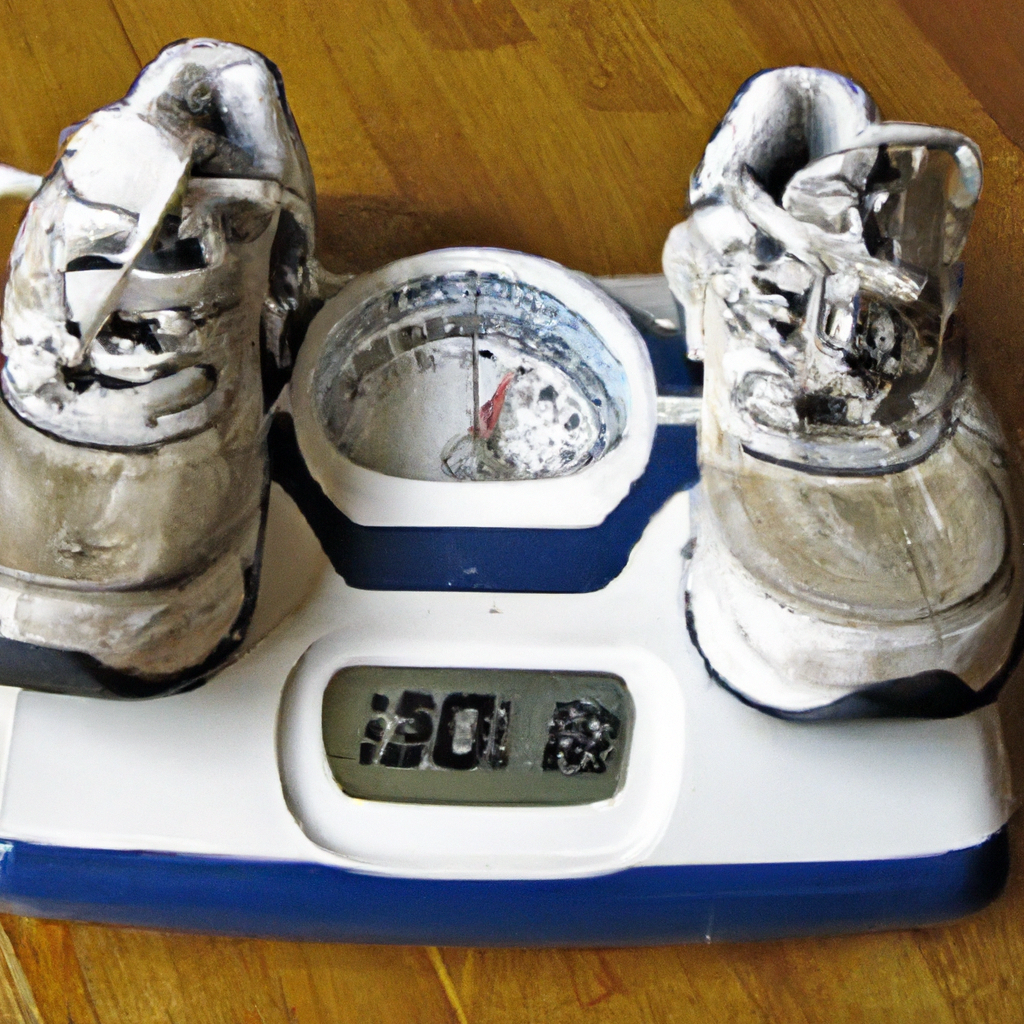Have you ever wondered how much weight you can lose in just one month by incorporating a simple activity like walking into your daily routine? Walking is a low-impact exercise that can be easily incorporated into anyone’s lifestyle. Whether you’re aiming to shed a few extra pounds or kick-start your weight loss journey, this article will guide you through the potential benefits and weight loss possibilities that can be achieved by walking regularly for just one month. Get ready to take those first steps towards a healthier and fitter you!
Factors to Consider
Current weight
Your current weight is an important factor to consider when determining how much weight you can lose in one month by walking. Generally, the more overweight you are, the more calories you will burn during physical activity, including walking. However, it’s important to set realistic goals and not expect to lose an excessive amount of weight in a short period of time. Remember, slow and steady weight loss is more sustainable and healthier for your body.
Walking speed
The speed at which you walk can also impact the amount of weight you can lose. Walking at a faster pace will generally burn more calories than walking at a slower pace. However, don’t feel pressured to walk at an unnaturally fast speed. Find a pace that is comfortable for you, as consistency is key when it comes to weight loss.
Duration and frequency
The duration and frequency of your walks will also play a role in how much weight you can lose in a month. Aim for at least 150 minutes of moderate-intensity walking per week, according to the American Heart Association. This can be broken down into 30 minutes of walking on most days of the week. Consistency is important, so try to establish a routine that you can stick to.
Diet and nutrition
While walking can aid in weight loss, it’s crucial to remember that diet and nutrition also play a significant role. To lose weight effectively, it’s important to consume a balanced and nutrient-dense diet that is appropriate for your individual needs. Focus on eating whole foods, such as fruits, vegetables, lean proteins, and whole grains, while limiting processed foods and added sugars.
Overall health
Your overall health can impact your ability to lose weight through walking. If you have any underlying health conditions or limitations, it’s important to consult with a healthcare professional before starting a new exercise regimen. They can provide guidance on how to safely incorporate walking into your routine and help you set realistic goals.
Genetics
While genetics can influence certain aspects of weight loss, such as your metabolism and body composition, it’s important to remember that they do not solely determine your weight loss success. Walking can be an effective tool for weight loss regardless of your genetic factors. Focus on the factors that you can control, such as your diet, physical activity, and overall lifestyle choices.
Understanding Weight Loss
Caloric deficit
Weight loss ultimately comes down to creating a caloric deficit, which means you are burning more calories than you are consuming. Walking can contribute to this caloric deficit by burning additional calories. However, keep in mind that the number of calories burned during a walk will vary depending on factors such as your weight, walking speed, and duration of the walk.
One pound rule
The one pound rule serves as a general guideline for weight loss. It suggests that a caloric deficit of approximately 3,500 calories will lead to a one-pound weight loss. By incorporating walking into your routine, you can create this deficit over time. For example, if you aim to walk for 30 minutes a day, you can burn additional calories and potentially lose weight.
Muscle mass
Walking can also play a role in maintaining or building muscle mass. While walking is primarily a cardiovascular exercise, it can still engage the muscles in your legs, glutes, and core. Building and maintaining muscle mass can lead to increased calorie burning throughout the day, even at rest. This can aid in weight loss and overall body composition.
Fat loss vs. water weight
It’s important to understand that weight loss can come in different forms. While walking can help with fat loss, it may also contribute to temporary water weight loss. As you engage in physical activity, your body may release excess water through sweat. However, this water weight can fluctuate and may not necessarily reflect fat loss. Focus on sustained and healthy weight loss rather than solely relying on changes in water weight.

Benefits of Walking for Weight Loss
Low impact exercise
One of the major advantages of walking for weight loss is that it is a low impact exercise. This means that it puts minimal stress on your joints and muscles, reducing the risk of injuries or strain. Whether you’re a beginner or have preexisting conditions, walking provides a safe and effective way to engage in physical activity without undue pressure on your body.
Accessible and easy to do
Walking is a form of exercise that is accessible to almost everyone. You don’t need any special equipment or a gym membership to get started. Simply put on a comfortable pair of shoes and head out for a walk. Whether it’s around your neighborhood, a local park, or even on a treadmill, walking can be easily incorporated into your daily routine.
Boosts metabolism
Regular walking can help boost your metabolism, which is the rate at which your body burns calories. By increasing your metabolic rate, your body becomes more efficient at using energy, including stored fat, for fuel. This can contribute to weight loss and make it easier to maintain a healthy weight over time.
Improves cardiovascular health
Walking is a form of aerobic exercise, and regular aerobic activity is known to improve cardiovascular health. Walking increases your heart rate, strengthens your heart and lungs, and improves blood circulation. By incorporating walking into your routine, you can reduce the risk of heart disease, high blood pressure, and other cardiovascular conditions.
Enhances mood
Walking can have a positive impact on your mental health and overall mood. Physical activity releases endorphins, which are known as the “feel-good” hormones. Regular walking can help reduce stress, anxiety, and symptoms of depression. It provides an opportunity to connect with nature, enjoy fresh air, and clear your mind. Walking with a friend or a loved one can also make it a social and enjoyable experience.
Setting Realistic Expectations
Sustainable weight loss
When embarking on a weight loss journey, it’s essential to set realistic and sustainable goals. Aim to lose 1-2 pounds per week, which is considered a healthy rate of weight loss. Rapid and extreme weight loss is often not sustainable and can lead to negative health consequences. Remember, losing weight is a journey, and it’s important to focus on long-term lifestyle changes rather than short-term fixes.
Healthy target range
Rather than aiming for a specific number on the scale, it’s important to focus on achieving a healthy target weight range. This range can be determined by factors such as your height, body composition, and overall health. Your healthcare professional can assist you in setting a realistic target range that takes into account your individual needs and circumstances.
Average weight loss
The average weight loss achievable through walking alone may vary from person to person. Generally, a consistent walking routine combined with a balanced diet can lead to a weight loss of approximately 1-2 pounds per week. However, it’s important to remember that weight loss is influenced by various factors such as genetics, body composition, and overall lifestyle habits.

Sample Walking Plan
Setting a goal
To start your walking plan, it’s important to set a clear and achievable goal. This goal can be based on the duration or distance you want to walk, or the number of steps you want to take each day. Set realistic goals that challenge you but are attainable within your current fitness level. Write down your goal and track your progress to stay motivated and accountable.
Starting slow and gradually increasing
If you’re just starting out or have been inactive for a while, it’s important to start slow and gradually increase the intensity and duration of your walks. Begin with shorter walks at a comfortable pace and slowly increase your walking time or distance each week. This gradual progression allows your body to adapt and helps prevent injuries.
Adding variety
To keep your walking routine exciting and avoid plateauing, add variety to your walks. Explore different routes, walk in different environments such as parks or beaches, or try interval training where you alternate between brisk walking and slower-paced walking. Changing things up can help prevent boredom and keep you engaged in your fitness journey.
Accounting for rest days
Rest days are an important part of any exercise routine, including walking. It’s important to allow your body time to recover and repair itself. Incorporate rest days into your walking plan to prevent overuse injuries and burnout. Use these rest days to engage in other forms of low-impact activities such as stretching, yoga, or light strength training.
Tips for Maximizing Weight Loss
Maintain a consistent routine
Consistency is key when it comes to maximizing weight loss through walking. Aim to establish a consistent walking routine by scheduling your walks at the same time each day or on specific days of the week. Make walking a priority and treat it as an important appointment with yourself. By sticking to a routine, you’re more likely to stay motivated and achieve your weight loss goals.
Increase intensity
To maximize weight loss, gradually increase the intensity of your walks. This can be done by incorporating intervals of higher intensity or inclines. For example, you can alternate between brisk walking and jogging or find hilly routes to challenge your muscles and cardiovascular system. Increasing the intensity of your walks can help burn additional calories and improve your overall fitness level.
Incorporate strength training
While walking primarily focuses on cardiovascular fitness, it’s important to incorporate strength training into your overall exercise routine. Strength training helps build lean muscle mass, which can increase your metabolism and aid in weight loss. Include exercises such as bodyweight squats, lunges, push-ups, and planks into your routine on non-walking days to further enhance your weight loss efforts.
Watch calorie intake
Although walking can help create a caloric deficit, it’s important to also pay attention to your calorie intake. Losing weight requires a combination of increased physical activity and a balanced diet. Be mindful of portion sizes, choose nutrient-dense foods, and aim to create a calorie deficit through a combination of exercise and healthy eating.
Stay hydrated
Proper hydration is essential for overall health and weight loss success. Drinking an adequate amount of water throughout the day can help boost your metabolism, control cravings, and ensure proper bodily functions. Carry a water bottle with you during your walks and aim to drink water regularly to stay hydrated and support your weight loss efforts.

Safety Precautions
Consult with a healthcare professional
Before starting any new exercise regimen, including a walking plan for weight loss, it’s important to consult with a healthcare professional. They can evaluate your overall health, address any concerns or limitations you may have, and provide personalized recommendations. It’s especially important to seek medical advice if you have any underlying health conditions or have been sedentary for an extended period.
Proper footwear
Investing in a good pair of walking shoes is crucial for your safety and comfort. Look for shoes that provide proper support, cushioning, and stability. Ill-fitting or worn-out shoes can increase the risk of foot, ankle, and knee injuries. Visit a specialty store to get fitted for the right pair of shoes that suit your individual needs and walking style.
Warm-up and cool-down
Before starting your walk, it’s important to warm up your muscles to prevent injuries. Spend a few minutes performing dynamic stretches and light movements to gradually increase your heart rate and prepare your body for exercise. After your walk, take a few minutes to cool down and stretch to reduce muscle soreness and promote flexibility.
Listen to your body
Pay attention to your body’s signals and adjust your walking routine accordingly. If you experience pain, dizziness, or shortness of breath during your walk, slow down or stop and rest. Overexertion can lead to injuries or other health complications. Be mindful of your limitations and gradually progress at a pace that feels comfortable and safe for you.
Monitoring Progress
Weigh-ins
Monitoring your weight through regular weigh-ins can provide insight into your progress. However, keep in mind that weight can fluctuate due to factors such as water retention or muscle gain. Weigh yourself at the same time of day, preferably in the morning, to get a consistent measurement. Focus on long-term trends rather than day-to-day fluctuations.
Measurements
In addition to weighing yourself, taking body measurements can provide a more comprehensive picture of your progress. Measure your waist, hips, thighs, and other areas of interest to track changes in body composition. While the scale may not always reflect your progress accurately, measurements can help you see changes in your overall shape and size.
Fitness tracking apps
Utilizing fitness tracking apps on your smartphone or wearable device can help you monitor and analyze your walking progress. These apps can track important metrics such as distance, speed, calories burned, and even heart rate. They can provide motivation, allow you to set goals, and serve as a visual representation of your progress over time.
Keeping a journal
Keeping a journal or diary to record your daily walks, feelings, and observations can be a valuable tool in monitoring your progress. Use this journal to note any improvements in your endurance, mood, or general well-being. Reflect on your achievements and challenges, and celebrate your victories along the way. Journaling can serve as a source of inspiration and motivation throughout your weight loss journey.
Other Factors Affecting Weight Loss
Sleep quality
The quality and duration of your sleep can impact your weight loss progress. Lack of sleep can disrupt your hormones, increase appetite, and lower your energy levels, making it harder to stick to your walking routine and make healthy food choices. Aim for 7-9 hours of quality sleep per night to support optimal health and weight loss.
Stress levels
Chronic stress can have a negative impact on weight loss. Stress can lead to emotional eating, disrupt sleep patterns, and increase the production of cortisol, a hormone associated with weight gain. Incorporate stress management techniques into your routine, such as meditation, deep breathing exercises, or engaging in hobbies that help you relax and unwind.
Hydration
Proper hydration is important for overall health and can support weight loss efforts. Water helps regulate your body temperature, aids in digestion, and can help control appetite. Thirst can often be mistaken for hunger, so staying hydrated can help prevent unnecessary snacking. Aim to drink at least eight glasses of water per day or more if you are physically active or in hot weather.
Alcohol consumption
Alcoholic beverages are often high in calories and can hinder weight loss progress. Alcohol is also known to lower inhibitions and increase cravings for unhealthy foods. If you choose to consume alcohol, do so in moderation and be mindful of your choices. Opt for lower-calorie options, such as light beer or wine, and avoid sugary cocktails or excessive drinking.
Medications
Certain medications can affect weight loss progress by slowing down metabolism or causing water retention. If you are taking any medications, it’s important to discuss their potential impact on weight loss with your healthcare professional. They can provide guidance on how to manage the effects of medication while still working towards your weight loss goals.
Maintaining Weight Loss
Lifestyle changes
To maintain weight loss, it’s important to adopt healthy lifestyle changes that are sustainable in the long term. This includes continuing with regular physical activity such as walking, making balanced food choices, managing stress, prioritizing sleep, and staying hydrated. Focus on creating habits that promote overall health and well-being rather than solely focusing on the number on the scale.
Continuing an exercise routine
Once you’ve reached your weight loss goals, it’s crucial to continue with an exercise routine to maintain your progress. Walking can be an enjoyable and sustainable form of exercise that you can incorporate into your daily life. Gradually increase the intensity or duration of your walks as you progress to challenge your body and maintain your fitness level.
Healthy eating habits
Maintaining a balanced and nutritious diet is key to long-term weight maintenance. Focus on consuming whole foods, including plenty of fruits, vegetables, lean proteins, and whole grains. Be mindful of portion sizes and practice mindful eating, paying attention to your body’s hunger and fullness cues. Aim for a healthy balance and moderation rather than strict diets or restrictive eating patterns.
In conclusion, walking can be a valuable tool for weight loss when combined with a balanced diet and other healthy lifestyle habits. By considering factors such as your current weight, walking speed, duration, and frequency, as well as understanding the science behind weight loss and the benefits of walking, you can set realistic expectations and maximize your weight loss efforts. Remember to prioritize safety, monitor your progress, and make sustainable lifestyle changes to maintain your weight loss in the long term. With consistency, patience, and a positive mindset, walking can help you achieve your weight loss goals and improve your overall health and well-being.







